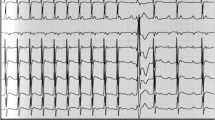Summary
The choice of the optimal mode for pacing in children depends on the age of the child and the indication. Ventricular demand pacing offers the advantage of simplicity and is ideal as a safety measure for children who have paroxysmal abnormalities. In the rate responsive ventricular pacing mode (VVIR) the pacing rate is adjusted automatically by an additional sensor that detects activity. Due to the potential risk of late venous thrombosis in young children, it is our policy to implant VVIR units in children less than 20kg who have atrioventricular (AV) block and normal heart structures, and to upgrade them to dual chamber units when the generator has to be replaced. The results of VVIR pacing are good and children have a normal level of exercise. The atrial demand mode (AAI) is indicated in children who present with symptoms related to sinus bradycardia, which is usually the consequence of atrial surgery. AAI pacing alone is selected when patients have satisfactory sinus acceleration and normal AV conduction at exercise; AAIR pacing is considered in those with permanent chronotropic incompetence. As the sinus node is the best sensor to increase the ventricular rate, atrial sensing ventricular pacemakers (DDD mode) are the best choice for children with congenital AV block. Infants are paced by the epicardial approach and the results have been very good in 34 patients who were operated in the last ten years. Transvenous endocardial DDD pacing is selected only in children older than 7 years (or 20–25kg) exept for those who have complex heart malformations and need AV synchrony. Pacemakers with mode switching algorithms should be selected in all patients who have AV block and paroxysmal atrial tachycardias. Finally, new indications have been developed in children with atrial tachycardia, in whom atrial antitachycardia pacemakers (AAIT) may terminate episodes of re-entry. Specific pacemaker options should be tailored to individual needs and close follow-up is necessary.
Similar content being viewed by others
Author information
Authors and Affiliations
Additional information
Received: 31 January 1999 Accepted: 21 November 1999
Rights and permissions
About this article
Cite this article
Villain, E. Choice of pacing mode in children: indications and results. Herzschr Elektrophys 10, 215–221 (1999). https://doi.org/10.1007/s003990050068
Issue Date:
DOI: https://doi.org/10.1007/s003990050068




